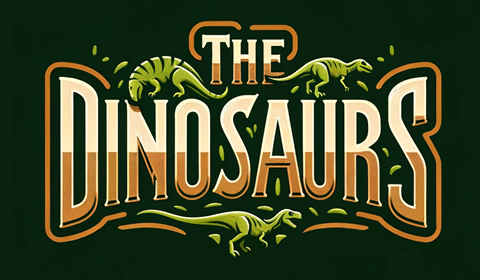When we delve into the world of dinosaurs, it’s like opening a time capsule that takes us back millions of years. Today, let’s embark on a journey to discover Goyocephale, a fascinating creature that roamed the earth during the Late Cretaceous Period. This dinosaur, whose name intriguingly means ‘Decorated Head’, offers a unique glimpse into a bygone era, and its story is as captivating as it is enlightening.
Goyocephale, a name that rolls off the tongue as “goy-oh-keff-ah-lee”, is a testament to the diversity and complexity of cretaceous life. Its discovery in the rugged terrains of Mongolia not only expanded our understanding of dinosaur evolution but also painted a vivid picture of the ancient ecosystems that once thrived on our planet.
Goyocephale Key Facts
| Keyword | Fact |
|---|---|
| Pronunciation | goy-oh-keff-ah-lee |
| Meaning of name | Decorated Head |
| Group | Pachycephalosaurs |
| Type Species | Goyocephale lattimorei |
| Diet | Herbivore |
| When it Lived | 71 to 69 MYA |
| Period | Late Cretaceous |
| Epoch | Early Maastrichian |
| Length | Approximately 6.0 feet |
| Height | Approximately 1.5 feet |
| Weight | Approximately 20.0 to 90.0 pounds |
| Mobility | Moved on two legs |
| First Discovery | 1977 by Halszka Osmólska |
| Described by | 1982 by Altangerel Perle, Teresa Maryańska, and Halszka Osmólska |
| Holotype | GI SPS 100/1501 |
| Location of first find | Ömnögov (Southern Gobi desert), Mongolia |
Goyocephale Origins, Taxonomy and Timeline
Goyocephale, with its name derived from the Mongolian word ‘goyo’ meaning ‘decorated, elegant’ and the Greek ‘kephale’ for head, is a fascinating subject in the study of ancient creatures. This name not only reflects its unique physical characteristics but also highlights the cultural and linguistic interplay in the field of paleontology.
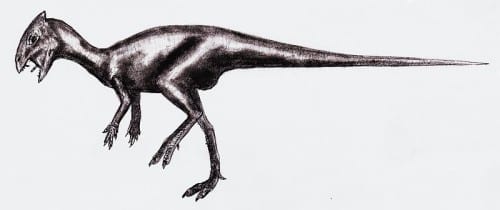
Belonging to the Pachycephalosauria, Goyocephale is a member of the pachycephalosaurid. This classification places it within a distinctive group of dinosaurs known for their thick-skulled characteristics. The specific species, Goyocephale lattimorei, further distinguishes it within the genus Goyocephale, underscoring its unique evolutionary path.
The timeline of this dinosaur is particularly intriguing. It thrived during the Late Cretaceous Period, specifically in the Maastrichtian (early Maastrichian). This places its existence approximately between 71 and 69 million years ago, a period marked by significant geological and climatic changes.
Listen to Pronunciation
For a more immersive experience, check out this video on how to pronunciate Goyocephale.
Discovery & Fossil Evidence
The only known remains of Goyocephale were discovered in 1977 by Halszka Osmólska in the Ömnögov region of South Gobi, Mongolia. It was later described and published in 1982 by Altangerel Perle, Teresa Maryańska, and Halszka Osmólska.
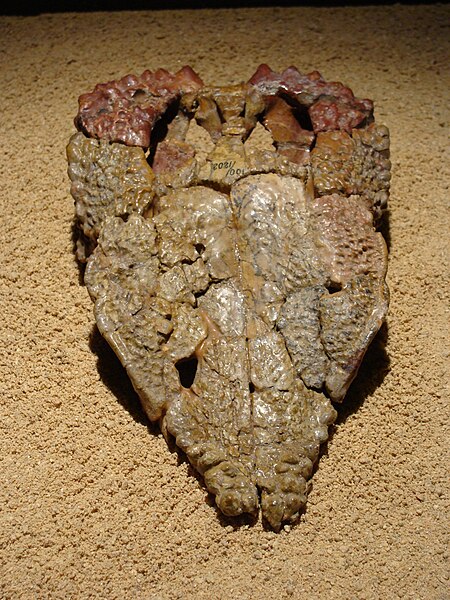 Holotype skull, dorsal view
Holotype skull, dorsal view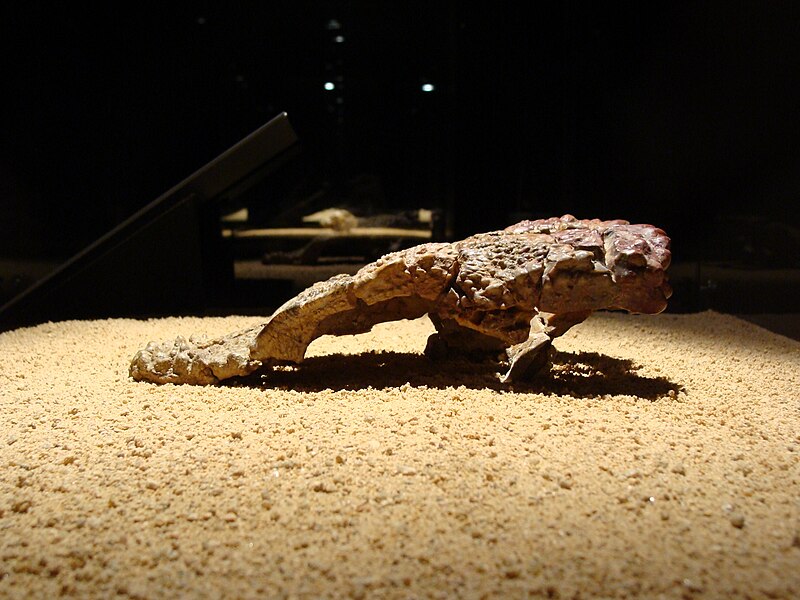 Goyocephale lattimorei in the exhibition “Dinosaures. Tresors del desert de Gobi” (“Dinosaurs. Treasures of Gobi Desert”) in CosmoCaixa, Barcelona.
Goyocephale lattimorei in the exhibition “Dinosaures. Tresors del desert de Gobi” (“Dinosaurs. Treasures of Gobi Desert”) in CosmoCaixa, Barcelona.
The holotype GI SPS 100/1501, an incomplete skeletton, have provided invaluable insights into its physical structure and lifestyle. While the degree of preservation varies, these fossils have been instrumental in reconstructing the appearance and habits of this unique dinosaur.
Goyocephale Size and Description
Goyocephale’s physical characteristics are a fascinating study in dinosaur anatomy. With a body adapted for bipedal locomotion, it moved on two legs, a feature that suggests agility and perhaps a certain level of speed. The most striking feature, however, is its ‘decorated’ head, which likely played a role in its survival and interaction with other species.
These unique features not only set Goyocephale apart from other dinosaurs but also provide insights into its adaptability and survival instincts. The thick skull, for instance, could have been used for defensive purposes or perhaps even in intraspecies combat.
Size and Weight of Type Species
The exact size and weight of Goyocephale remain a subject of ongoing research and debate. While specific measurements are not available, examining related species within the pachycephalosaurid can offer some clues. Typically, these dinosaurs were not among the largest of their time, suggesting a moderate size for the Goyocephale.
The Ultimate Dino Quiz
Do you want to test your knowledge on dinosaurs? Then try this Ultimate Dino Quiz! Don’t worry if you get some of the answers wrong, and look at it as an opportunity to refresh and improve your knowledge!
Don’t forget to try our other games as well!
Contemporary Dinosaurs
In the ancient landscapes of what we now call Mongolia, Goyocephale, a small, hard-headed dinosaur, scuttled among the towering legs of its contemporaries. The Nemegt Formation provided dozens of dinosaurs, including Gobisaurus, Tarbosaurus, Gallimimus, Deinocheirus, Therizinosaurus, Nemegtosaurus or Saichania.
Goyocephale, with its thick skull, might have seemed like an oddball next to the more famous Tarbosaurus. The tiranosaurid, bigger in size, was a cunning predator, swift and lethal. Imagine a tense encounter between these two: Goyocephale, using its domed head as a defense, while Tarbosaurus circled, looking for an opening. It was a classic underdog story, where brains might outwit brawn in a world ruled by tooth and claw.
But not all interactions were fraught with tension. Gobiraptor and the armored Saichania, larger than the rest, likely coexisted more peacefully with Goyocephale. These encounters, perhaps at a shared water source, would have been a study in cautious curiosity. Goyocephale, ever the observer, might have watched from a safe distance as these diverse creatures interacted, each playing their unique role in the rich tapestry of their shared ecosystem. In this ancient world, Goyocephale was not just a survivor, but a witness to the incredible diversity and complexity of life millions of years ago.
Interesting Points about Goyocephale
- Goyocephale’s name, meaning ‘Decorated Head’, is a direct reference to its distinctive skull features.
- It belonged to the pachycephalosaurid family, known for their thick skulls.
- This dinosaur lived during the Late Cretaceous Period, a time of significant geological and climatic changes.
- The first fossils were discovered in Mongoliam Gobi desert, a region rich in dinosaur history.
- Goyocephale’s bipedal locomotion suggests it was agile and possibly quite swift.
Goyocephale in its Natural Habitat
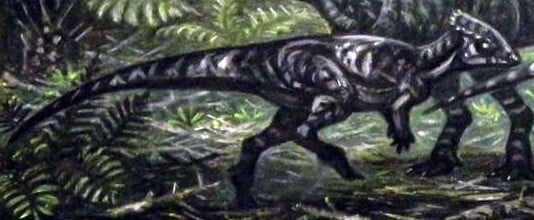
Goyocephale thrived in the diverse and dynamic ecosystems of the Late Cretaceous Period. The climate during this era was varied, with regions experiencing different environmental conditions. In the areas where it lived, lush vegetation likely provided ample food sources for this herbivorous dinosaur.
As a herbivore, Goyocephale’s diet would have primarily consisted of the plant life abundant in its habitat. Its mobility, moving adeptly on two legs, suggests it could have easily navigated through dense vegetation, foraging for food. The social behavior of Goyocephale is less clear, but it could have ranged from solitary to living in small groups.
The impact of Goyocephale on its environment is an intriguing aspect to consider. As a herbivore, it would have played a role in shaping the vegetation patterns of its habitat, possibly even influencing the ecosystem’s overall health and diversity.
Frequently Asked Questions
It means ‘Decorated Head’, a reference to its distinctive skull features.
This dinosaur lived during the Late Cretaceous Period, approximately 71 to 69 million years ago.
It was first discovered in the Ömnögov region of Southern Gobi, Mongolia.
It was a herbivore, feeding on the vegetation of its time.
Its most distinctive feature is its thick, ‘decorated’ skull.
It moved on two legs, suggesting a certain level of agility and speed.
Sources
The information in this article is based on various sources, drawing on scientific research, fossil evidence, and expert analysis. The aim is to provide a comprehensive and accurate overview of Goyocephale. However, please be aware that our understanding of dinosaurs and their world is constantly evolving as new discoveries are made.
- https://www.app.pan.pl/archive/published/app27/app27-115.pdf
- https://www.researchgate.net/publication/240625747_A_taxonomic_review_of_the_Pachycephalosauridae_Dinosauria_Ornithischia
- https://www.researchgate.net/publication/267785017_A_new_pachycephalosaurid_from_the_Baynshire_formation_Cenomanian-Late_Santonian_Gobi_Desert_Mongolia
This article was last fact-checked: Joey Arboleda, 11-29-2023
